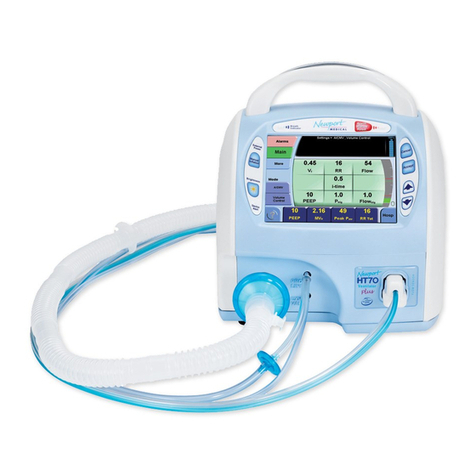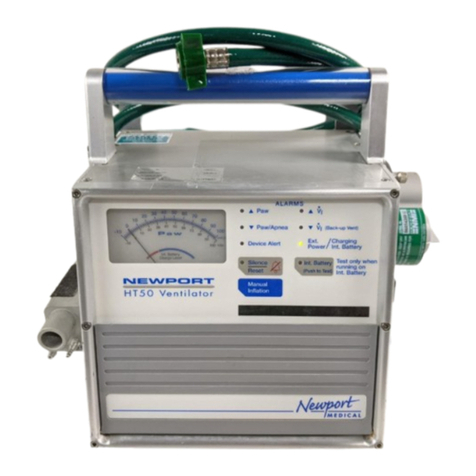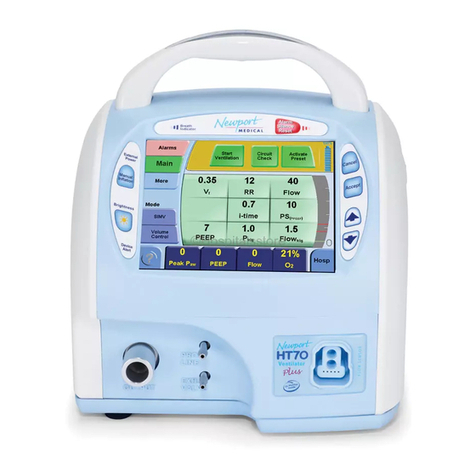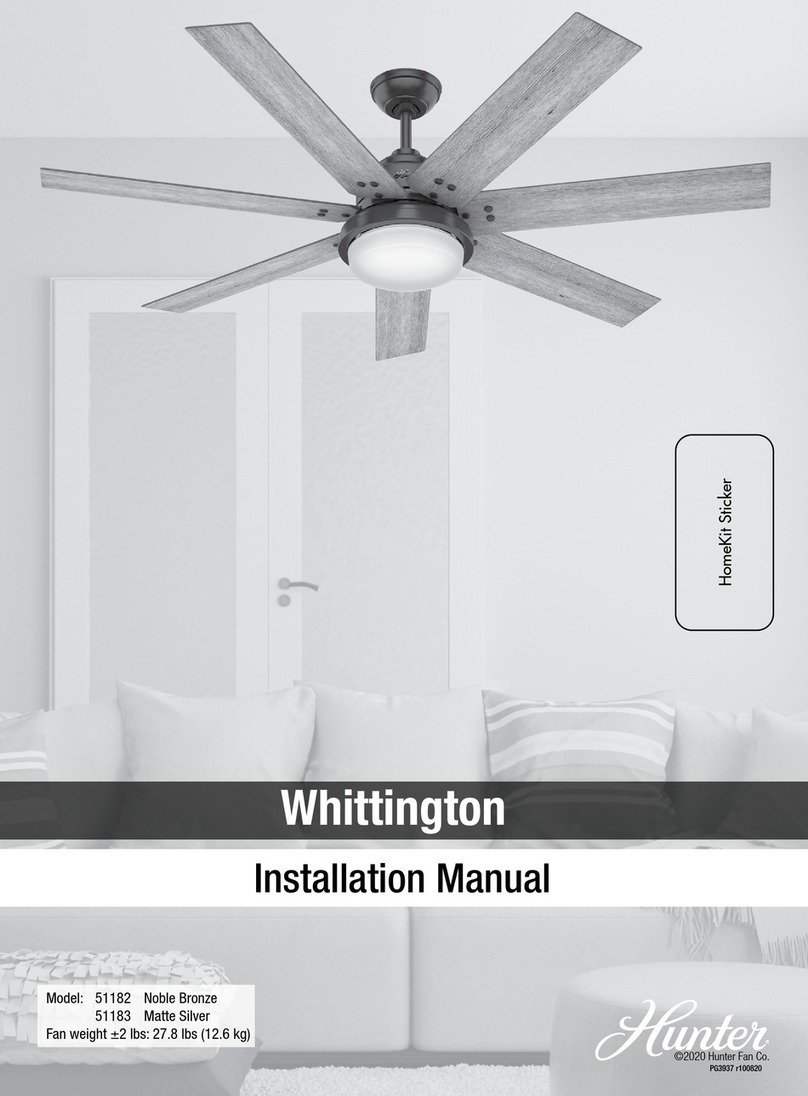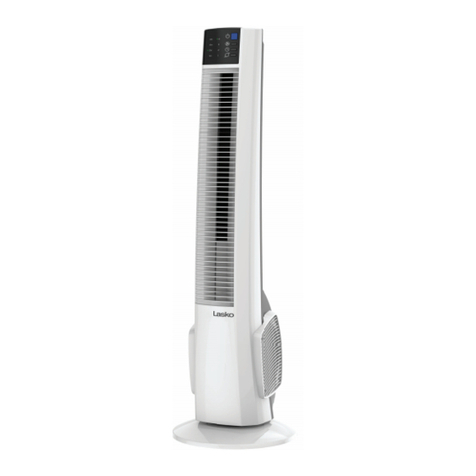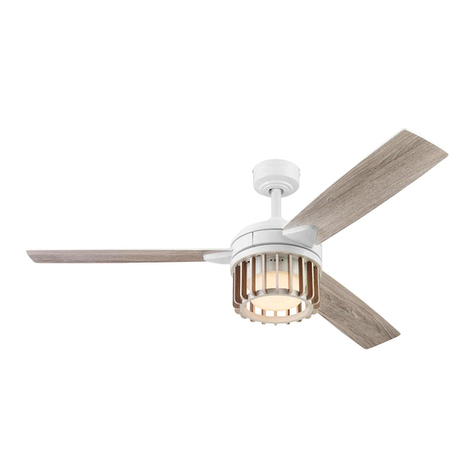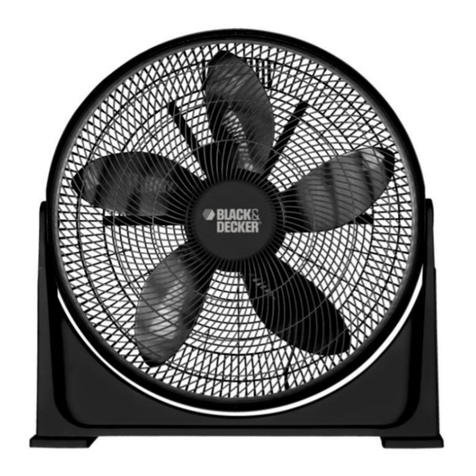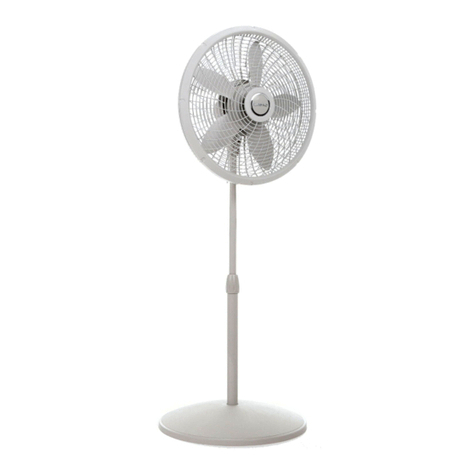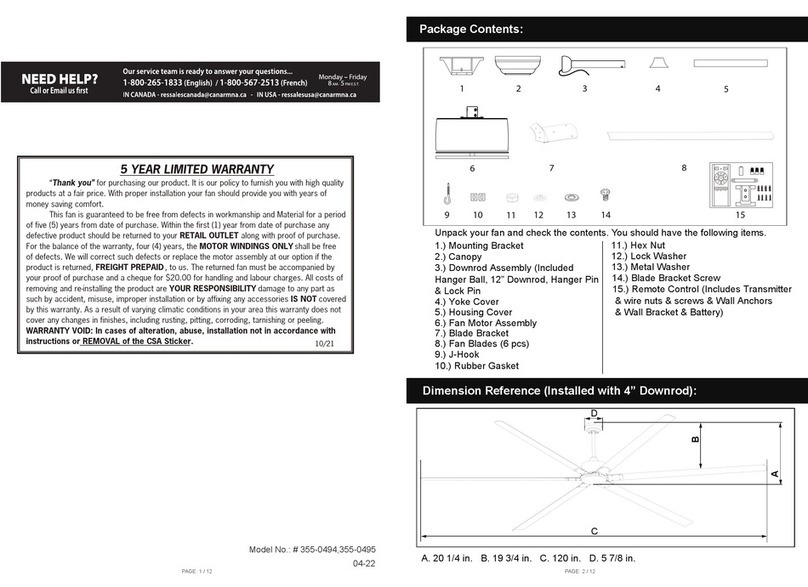Newport Medical Instruments Newport HT50 User manual

Newport Medical Instruments, Inc.
NEWPORT HT50 VENTILATOR
Operating Manual
OPRHT50NA Rev. B
September 2008
Exclusively Distributed by:
Newport Medical Instruments, Inc.
1620 Sunflower Ave
Costa Mesa, CA 92626 USA
Tel: 800.451.3111 (US only) +714.427.5811
Fax: +714.427.0489
Customer Service ext. 282
Technical Service ext. 500
www.NewportNMI.com
email: [email protected]

MANUAL REVISION HISTORY
OPRHT50NA B0908
HT50 Operating Manual OPRHT50NA
DATE REVISION PAGES EFFECTED
September 2007 A New release, for dual internal battery
updates from OPRHT50B rev. D - 2-2,
2-3, 2-4, 2-5, 2-6, 3-12, 3-13, 6-8, 7-2,
7-3, 7-7, A-7
September 2008 B Updated to include additional dual
internal battery data, update intended
use statement, refine cleaning and
sterilization section

OPRHT50NA B0908
TABLE OF CONTENTS
Section 1 . . . . . . . . . . OPERATOR’S RESPONSIBILITY
• Operator’s Responsibility for Patient Safety
• Limitation of Liability
• Warranty
• Definitions
• Typing Conventions
• Warnings and Cautions
• Factory Maintenance or Repair
• Contact Information
Section 2 . . . . . . . . . . SPECIFICATIONS
• Intended Use
• Symbols / Labeling Table
• Controls / Alarms / Monitors
• Hardware Requirements
• Miscellaneous Specifications
• Humidifier Specifications
• Air / Oxygen Entrainment Mixer Specifications
• Oxygen Blending Bag Kit Specifications
Section 3 . . . . . . . . . . DESCRIPTION OF CONTROLS, INDICATORS,
ALARMS & CONNECTORS
• Front Panel Overview
• Front Panel Controls & Indicators
• Front Panel Alarms
• Front Panel Message Display Window
• Left Side Connectors
• Right Side Connectors
• Optional Accessories
• User Set Up
Section 4 . . . . . . . . . . THEORY OF OPERATION
• General System Overview
• A/CMV Mode (Assist/Control Mandatory Ventilation)
• SIMV Mode (Synchronized Intermittent Mandatory
Ventilation)
• SPONT Mode (Spontaneous Ventilation)
• Psupport (Pressure Support)
• Pressure Control Ventilation
• Volume Control Ventilation
• Back-Up Ventilation

ii OPRHT50NA B0908
Section 5 . . . . . . . . . . VENTILATION SET UP & USE
• Introduction
• Assembling the Ventilator
• Ventilator Set Up Procedure with
Exhalation Valve Calibration
• Patient Set Up Procedure
• Built-in Humidifier (model HT50-H, HT50-HB)
• Air / Oxygen Entrainment Mixer (Optional Accessory)
• Oxygen Blending Bag Kit (Optional Accessory)
Section 6 . . . . . . . . . . CLEANING & MAINTENANCE
• Cleaning & Disinfecting
• Maintenance
• General Warnings
Section 7 . . . . . . . . . . TROUBLESHOOTING
• Introduction
• Table 7-1 Alarms
• Table 7-2 Built-in Humidifier
• Table 7-3 General / Clinical
• Table 7-4 Setting Limitation Messages
Appendix A . . . . . . . . QUICK CHECK PROCEDURE
• Introduction
• Set Up
• Standard Test Settings
• Quick Check Procedure
• Pass / Fail Check Off Sheet
• Abbreviated Check Procedure
Appendix B . . . . . . . . HT50 ACCESSORIES
• HT50 Parts & Accessories
Appendix C . . . . . . . . HT50 HELP GUIDE
• Questions & Answers

OPRHT50NA B0908
1. OPERATOR’S RESPONSIBILITY
Operator’s Responsibility for Patient Safety . . . . . 1-1
Limitation of Liability . . . . . . . . . . . . . . . . . . . . . . . 1-2
Warranty . . . . . . . . . . . . . . . . . . . . . . . . . . . . . . . . . 1-2
Definitions. . . . . . . . . . . . . . . . . . . . . . . . . . . . . . . . 1-3
Typing Conventions . . . . . . . . . . . . . . . . . . . . . . . . 1-3
Warnings and Cautions . . . . . . . . . . . . . . . . . . . . . 1-3
Factory Maintenance or Repair . . . . . . . . . . . . . . 1-7
Contact Information . . . . . . . . . . . . . . . . . . . . . . . . 1-7

SECTION 1
OPRHT50NA B0908 1-1
OPERATOR’S RESPONSIBILITY FOR PATIENT SAFETY
The Operating manual (p/n OPRHT50-NA) contains information
intended to ensure safe and effective ventilator use. The label on
the inside of the front panel cover door is meant to complement
not replace the Operating manual.
The design of the HT50 ventilator, the Operating and Service
manuals, and the labeling on the ventilator take into consideration
that the purchase and use of the equipment is restricted to trained
professionals, and that certain inherent characteristics of the
ventilator are known to the operator. Instructions, warnings and
caution statements are therefore limited to the specifics of the
Newport HT50.
Caution Federal law restricts this device to sale by or on the
order of a physician.
This manual excludes references to various hazards which are
obvious to medical professionals and operators of this equipment,
to the consequences of product misuse, and to potentially adverse
effects in patients with abnormal conditions.
When the HT50 is used in home care and sub acute environments it
is important that the primary caregiver has received training and has
demonstrated competency in all equipment functions. A specific
written care plan must be established by the attending physician.
Transport of patients with the HT50 requires that medical staff
have a good working knowledge of the ventilator’s use and
problem resolution. Proper emergency back-up equipment must
be immediately available during transport.
HT50 operators must recognize their responsibility for
implementing safety monitoring mechanisms which supply
appropriate information on equipment performance and patient
condition. Patient safety may be achieved through a wide variety
of means such as electronic surveillance of equipment
performance and patient condition. However, equipment
surveillance should not replace direct observation of clinical signs.
The HT50 operator is solely responsible for selecting the
appropriate level and method of patient monitoring.
Product modification or misuse can be dangerous. Newport
Medical Instruments, Inc. (NEWPORT) disclaims all liability for the
consequences of product alterations or modifications, as well as
for the consequences which might result from the combination of
this ventilator with other products, whether supplied by Newport or
by other manufacturers, unless such a combination has been
specifically endorsed by Newport.

OPERATOR’S RESPONSIBILITY
1-2 OPRHT50NA B0908
LIMITATION OF LIABILITY
The liability of Newport Medical Instruments, Inc. (NEWPORT) is
subject to and limited to the exclusive terms and conditions as set
forth herein. Said liability is limited whether arising out of, or related
to, the manufacture and sale of goods, their installation,
demonstration, sales representation, use, performance, or
otherwise. Any liability based upon product warranty, whether
breach of warranty or otherwise, is limited regardless of any fault
attributable to NEWPORT and the nature of the action (including
breach of warranty, negligence, and strict liability).
The expressed warranties are in lieu of all other warranties,
expressed or implied, including, without limitation, warranties of
merchantability, fitness for any purpose, or noninfringement.
NEWPORT shall not be liable for any special incidental or
consequential damages incurred by the buyer to a third party. The
buyer shall not be entitled to make liability recoveries from
NEWPORT due to such situations.
WARRANTY
The Newport HT50 Ventilator is guaranteed to be free of defects
for a period of two (2) years from date of delivery. The following are
exceptions to this warranty:
1. Defects caused by misuse, mishandling, tampering, or by
modifications not authorized by Newport Medical Instruments,
Inc. (NEWPORT) or its representatives.
2. Rubber and plastic components and materials are guaranteed
to be free of defects at time of delivery.
3. The internal batteries are warranted for six months.
Any product which proves to be defective in workmanship or
material will be replaced, credited, or repaired. Newport retains the
discretion to select the most suitable of these options. Newport is
not responsible for deterioration, wear, or abuse. In all cases,
Newport will not be liable beyond the original selling price.
Application of this warranty is subject to the following conditions:
1. NEWPORT or its authorized representatives must be promptly
notified upon detection of the defective material or equipment.
2. Defective material or equipment must be returned to NEWPORT
or its authorized representative.
3. Examination by NEWPORT or its authorized representatives must

SECTION 1
OPRHT50NA B0908 1-3
confirm that the defect is covered by the terms of this
warranty.
To ensure complete protection under this warranty, the Warranty
Registration Card must be returned to Newport within ten (10)
days of equipment receipt.
The above is the sole warranty provided by NEWPORT. No other
warranty, expressed or implied, is intended. Representatives of
Newport are not authorized to modify the terms of this warranty.
DEFINITIONS
WARNING Possibility of personal injury, to patient or others, if
disregarded.
Caution Possibility of equipment damage if disregarded.
NOTE: Additional information intended to avoid inconveniences
during operation. Notes also indicate important procedures to be
followed.
Inspection: Examination of actual condition.
Service: Measures required to maintain a specified condition.
Repair: Measures required to restore a specified condition.
Maintenance: Required inspection, service, and repair of the
device.
Preventive Maintenance: Maintenance performed at regular
intervals to keep the device in good working condition.
TYPING CONVENTIONS
Within the text of this manual, controls, alarms, and indicators are
designated by the labeling name as they appear on the ventilator,
e.g.: Psupport (pressure support), Ptrig (pressure trigger), and
SPONT (spontaneous mode).
Please review all WARNINGS and Cautions outlined in this
manual prior to using the HT50 for the first time.
WARNINGS AND CAUTIONS
At all times, strictly follow this Manual. The safe use of the HT50
Ventilator requires a full understanding of its operation and
adherence to the manual’s instructions. The equipment is only to
be used for the purpose specified under “Intended Use” (see

OPERATOR’S RESPONSIBILITY
1-4 OPRHT50NA B0908
Section 2). Observe all of the WARNINGS and Cautions posted in
this manual and on labels found on the HT50 Ventilator and
associated accessories.
General Warnings
External power connection: To maintain grounding integrity when
using A.C. power, only connect to hospital grade receptacles.
Always disconnect the external power supply prior to servicing.
Always use the A.C. power cord supplied with the HT50. Make
certain the power cord ferrite is always attached to the A.C. power
cord to ensure that the HT50 meets EMC requirements.
There is a risk of explosion if used in the presence of flammable
anesthetics.
All settings and adjustments in the different ventilation modes must
be made in accordance with a physician’s prescribed therapy.
NEWPORT cannot warrant or endorse the safe performance of third
party humidifiers for use with the HT50.
When the HT50 is operating on battery power, the optional built-in
humidifier does not function. A heat moisture exchanger, or other
humidification device, should be used until the unit is connected to
A.C. power at which time the built-in humidifier can be used.
Do not use electrically conductive patient circuits.
Always use a clean patient circuit.
Always use an inline filter (p/n HT6004701 or equivalent) at the
Airway Pressure Connector to protect the internal transducers from
moisture or other contaminants.
Always use appropriate monitors to ensure sufficient oxygenation
and ventilation (such as pulse oximeter and/or capnograph) when
the HT50 Ventilator is in use on a patient.
The ventilator is ready for operation only when:
a) It is completely assembled, and;
b) The Quick Check Procedure, including the Exhalation Valve
Calibration (see Appendix A, Operating Manual) or OVP
(Service Manual) has been successfully completed.
Constant attention by qualified medical personnel is recommended
whenever a patient is ventilated with the HT50.
When the HT50 is used in homecare environments, proper
education and training of the appointed caregiver must be
provided prior to the patient leaving the health care facility.
If a fault is detected in the ventilator and its life support functions
are in doubt, immediately discontinue use; use an alternative

SECTION 1
OPRHT50NA B0908 1-5
method of ventilation until the fault has been corrected. Contact
NEWPORT Technical Service Department immediately.
Failure to identify and correct alarm violations may result in patient
injury.
Continuous oxygen monitoring is required for patient safety. The
HT50 does not have a built-in alarm system to notify user of a
failure or disconnection of the oxygen source.
Ensure that the oxygen source is not empty before and during the
use of the optional Air/Oxygen Entrainment Mixer or Oxygen
Blending Bag Kit.
The primary internal battery should be replaced every 12 months
or sooner if the use time no longer meets the needs of the user.
This will depend on a number of factors including settings and
usage patterns. The secondary internal battery should be replaced
every 24 months.
Please recognize that any life support equipment should have
appropriate alternate power sources and means of ventilation
readily available in case of a mechanical or system problem. If you
need alternative power sources, contact Newport Medical
Instruments Inc.
When the HT50 is used for transport applications, ensure that the
internal battery system is fully charged prior to use.
When the Battery Empty audible alarm sounds continuously, only a
limited time of internal battery power remains and an alternate
power source should be found immediately.
Frequent deep discharge of the internal battery system will
decrease the amount of time the HT50 will operate on battery
power from a full charge state.
If you use the internal battery system as your primary power
source, replace the primary battery as needed to ensure that the
battery operation time is sufficient.
Charge the internal battery system for a minimum of 8 hours
before powering the ventilator from the internal batteries. This will
provide approximately 80% of the battery charge. If the battery
system is completely depleted, it will take approximately 10 hours
to fully recharge.
Always ensure that the green Ext. Power LED lights after
connecting the HT50 to an external AC or DC power source (it can
take up to two minutes to light). If the LED does not light, check all
power connections and resolve any problems.
Always plug the HT50 into an external power supply source when

OPERATOR’S RESPONSIBILITY
1-6 OPRHT50NA B0908
not in use to insure best battery performance.
The flow resistance of the air inlet filter, located on the right side of
ventilator, is likely to increase with repeated use. Ensure that the
filter is changed regularly.
The HT50 Ventilator is guaranteed to perform to specification when
the Newport HT50 breathing circuit with exhalation valve is used.
See Appendix B for circuit configurations and parts list.
Only NEWPORT approved exhalation valves can be used with
the HT50.
Perform an exhalation valve calibration each time a clean
circuit/exhalation valve is installed.
The functioning of this machine may be adversely affected by the
operation of equipment, such as high frequency surgical
(diathermy) equipment, defibrillators or short-wave therapy
equipment in the vicinity.
This equipment has been tested and found to comply with the
EMC limits for the Medical Device Directive 93/42/EEC (EN55011
Class A and EN 60601-1-2). These limits are designed to provide
reasonable protection against harmful interference in a typical
medical installation. The equipment generates, uses and can
radiate radio frequency energy and, if not installed and used in
accordance with these instructions, may cause harmful
interference to other devices in the vicinity. However, there is no
guarantee that interference will not occur in a particular installation.
If this equipment does cause harmful interference with other
devices, which can be determined by turning the equipment off
and on, the user is encouraged to try to correct the interference by
one or more of the following measures:
• Reorient or relocate the receiving device
• Increase the separation between the equipment
• Connect the equipment into an outlet on a circuit different
from that to which the devices(s) is connected
• Consult the manufacturer or field service technician for help.
Cautions
Only use medical grade oxygen with the Air/Oxygen Entrainment
Mixer or Oxygen Blending Bag Kit.
Do not place liquid containers in the immediate vicinity or on top of
the HT50. Liquids that get into the ventilator can cause equipment
malfunction and damage.

SECTION 1
OPRHT50NA B0908 1-7
After servicing an HT50, it must completely pass an Operational
Verification Procedure (see Service Manual) before being returned
to patient use.
An authorized Newport Medical Instruments factory-trained
technician must do all service or repairs performed on the HT50.
Do not open the ventilator or perform service on an open unit while
connected to external power.
Use standard anti-static techniques while working inside the
ventilator or handling any electronic parts.
Clean all external parts of the ventilator prior to servicing.
Water in the oxygen supply can cause equipment malfunction and
damage.
Always replace a blown fuse with one of proper rating for
corresponding voltage range.
NOTE: Review the HT50 Operating Manual and Theory of
Operation (Section 4 of this manual) before using the ventilator.
NOTE: Use the tools and equipment specified in this manual to
perform specific procedures.
Batteries contain materials that can harm the environment. Do not
discard them in an incinerator or force them open. Batteries
cannot be disposed of with normal waste.
Factory Maintenance or Repair
Scheduled maintenance or repair services are available from the
Newport Technical Service Department. To send your ventilator in
for service, see HT50 Service Manual for repackaging and
shipping instructions.
Current pricing for scheduled maintenance and labor rates can be
found in Newport Medical Instruments Annual Price List. To obtain
a copy, please contact your local Newport Sales Representative or
contact our Customer Service Department using information below.
Contact Information
Address: Newport Medical Instruments, Inc.
1620 Sunflower Ave
Costa Mesa, California, USA 92626

OPERATOR’S RESPONSIBILITY
1-8 OPRHT50NA B0908
Phone numbers: Toll-free within the United States:
800.451.3111
Worldwide: 1.714.427.5811
Fax numbers: Main fax: 1.714.427.0489
Technical Service fax: 1.714.427.0572
Website: www.NewportNMI.com /
www.ventilators.com
Email: [email protected]
Department
extensions: Customer Service: 282
Technical Service: 500 (24-hour pager activated
after Technical Service department hours)
Clinical Support: 123 (24-hour pager)
Corporate Office Monday through Friday, 8:00 am to 5:00 pm
hours: (USA Pacific Time)
Technical Service Monday through Friday, 7:00 am to 4:00 pm
hours: (USA Pacific Time)
HT50s distributed internationally have CE authorization (HT50-H, HT50-
H1) and are represented by: Obelis, s.a. , 34 Ave de Tervuren, bte 44, B-
1040 Brussels, Belgium. Tel: +32.2.732.59.54 Fax:+32.2.732.60.03
email:[email protected]

OPRHT50NA B0908
2. SPECIFICATIONS
Intended Use . . . . . . . . . . . . . . . . . . . . . . . . . . . . . 2-1
Symbols / Labeling Table . . . . . . . . . . . . . . . . . . . 2-1
Controls / Alarms / Monitors . . . . . . . . . . . . . . . . . 2-2
Hardware Requirements . . . . . . . . . . . . . . . . . . . . 2-5
Miscellaneous Specifications . . . . . . . . . . . . . . . . 2-5
Humidifier Specifications. . . . . . . . . . . . . . . . . . . . 2-7
Air / Oxygen Entrainment Mixer Specifications . . 2-7
Oxygen Blending Bag Kit Specification . . . . . . . . 2-8

SECTION 2
OPRHT50NA B0908 2-1
INTENDED USE
This device is intended to provide continuous or intermittent mechanical
ventilator support for the care of individuals who require mechanical
ventilation. The ventilator is a restricted medical device intended for use
by qualified, trained personnel under the direction of a physician.
Specifically, the HT50 is applicable for adult and pediatric (i.e. infant, child
and adolescent) patients, greater than or equal to 10 kg or 22 lbs., who
require the following general types of ventilatory support, as prescribed by
an attending physician: positive pressure ventilation with assist/control,
SIMV and SPONT modes of ventilation. The HT50 is suitable for use in
hospital, sub-acute, emergency room, home care environments as well as
for transport and emergency response applications.
Front panel controls allow trained operators to select between a number
of operational modes, pressure support and volume or pressure control.
A comprehensive alarm system is built-in to alert the user to violations
of set safety limits. When new and fully charged, the internal battery
system provides up to 10 hours of power. With its patented, self-
contained gas supply source, the HT50 requires no external air
compressor.
Main Power On
Main Power Standby
Equipotentiality
Refer to Operating Manual
Applied Parts Type BF
Alarm Setting
Audible Alarm Silence/Reset
High Alarm Set High Alarm
Low Alarm Set Low Alarm
|
▲▲
▼▼
SECTION 2

SPECIFICATIONS
2-2 OPRHT50NA B0908
SPECIFICATIONS
SYMBOLS/LABELING TABLE
Controls/Alarms/Monitors Range/Selection
1. MODE (Pressure or A/CMV
Volume Control) SIMV
SPONT
2. Volume Control (Tidal Volume) 100 to 2,200 mL, ATPS, ± 10%
3. Pressure Control PEEP +5 to 60 cmH2O / mbar
(Target Pressure)
4. V
•(Flow) 6 to 100 L/min
5. tI(Inspiratory Time) 0.1 to 3.0 sec
6. ƒ(Frequency) 1 to 99 b/min
7. Ptrig (Sensitivity) –9.9 to 0 cmH2O / mbar, pressure triggering
(Patient Effort Indicator LED blinks once each time the airway
pressure reaches the Ptrig setting.)
8. PEEP/CPAP 0 to 30 cmH2O / mbar
9. Psupport (Pressure Support) 0 to 60 cmH2O / mbar above baseline pressure,
limited to PEEP + Psupport ≤ 60 cmH2O / mbar
10. I:E Ratio 1:99 to 3:1
11. Maximum Limited Airway 100 cmH2O (98 mbar)
Pressure (Safety Valve)
12. Manual Inflation 3 sec maximum
(While button is pushed, the ventilator closes the exhalation
valve and delivers a operator controlled breath to the patient.)
13. Humidifier (Optional) 19ºC to 39ºC
14. Airway Pressure Meter –10 to 100 cmH2O / –10 to 98 mbar
15. Alarm Silence/Reset Button Pressing button silences an audible alarm violation for 60
& Indicator seconds and resets a latched alarm indicator. LED lights to
indicate that Silence is active.
16. ALARMS Indicators Indicators for violated alarms blink red. When the alarm is no
longer violated, the indicator latches (stays lit). Cancel a latched
indicator by pressing the Silence/Reset button.
17. Int. Battery Button & Indicator Pressing button displays the internal battery charge level in the
airway pressure meter (Paw) window. Use only when operating
on the internal battery system for accurate reading. LED lights
to indicate internal battery system operation and alarms.

SECTION 2
OPRHT50NA B0908 2-3
Controls/Alarms/Monitors Range/Selection
18. FIO20.21 to 1.00
(with optional accessories)
19. On / Standby Button Press once to put in Setting condition. (On-Setting/LED off)
Press again to begin ventilating (On-Ventilating/LED on).
When the HT50 is ventilating, press two times to put ventilator
into Standby/Off condition (LED off).
20. Push To Unlock Buttons & Pressing button unlocks front panel buttons if locked by
Indicator automatic panel lockfeature. Auto lock is enabled/disabled in User
Set Up. LED lights to indicate panel is locked.
21. Alarms
▲Paw (High Pressure) 4 to 99 cmH2O / 4 to 99 mbar, must be 1< Low Paw
▼Paw (Low Pressure) 3 to 98 cmH2O / 3 to 98 mbar, limited by ≥ PEEP + 3 and High
Paw -1
Low Baseline Pressure Paw < PEEP - 3 cmH2O/mbar for 3 sec during exhalation
High Baseline Pressure Paw > PEEP + 8 cmH2O/mbar at onset of a breath or 3 sec
after the start of exhalation
Occlusion Paw > PEEP + 15 cmH2O/mbar at onset of a breath or 3 sec
after start of expiration
Apnea 30 sec ± 3 sec
PCV Not Reached Paw P < 50% of PCV setting
▲V
•
I Insp. Min. Volume 1.1 to 50.0 L/min
▼V
•
I Insp. Min. Volume 0.1 to 49.0 L/min
Check Prox Line Prox Paw does not match machine Paw during inspiration
Humidifier (5 messages) Humidifier malfunction/disconnection
Power Switchover External power to internal battery switchover alert
Battery Low Minimum of 30 minutes battery time remains until shutdown
Battery Empty Minimum of 15 minutes battery time remains until shutdown
NOTE: The time between the Battery Low Alarm violation and the Battery Empty Alarm violation
will vary depending on the ventilator load. At high volumes and pressures, the Battery Empty
Alarm will occur much sooner after the Battery Low Alarm, than it will at lower volumes and
pressures. In all cases, the stated minimum times for each alarm will be met, even if the two
alarms occur almost simultaneously.
Device Alert (5 messages) Ventilator malfunction: FAULT BAT SYS, OCCLUSION, 10V
SHUTDOWN, SYSTEM ERROR or MOTOR FAULT
Shut Down Alert On to Standby/Off Shut Down Alert
22. Message Display Window
Up to 16 characters, LED alpha numeric display
Displayed monitored parameters:
VT(Actual delivered tidal volume)
V
•
I(Inspiratory minute volume)
ƒ(Total breath frequency)
Paw P (Peak airway pressure)
Paw M (Mean airway pressure)

SPECIFICATIONS
2-4 OPRHT50NA B0908
Paw B (Baseline airway pressure)
H (Hours of operation)
S (Software version)
L (or Q) (Buzzer volume (Loud or Quiet) for audible alarm)
Other displayed parameters
(In USER SET UP):
Power Save (On / Off)
Airway Pressure Units (cmH2O / mbar)
Set Up (User / Default)
Auto Panel Lock (Enabled / Disabled)
Tech. Setup (Technical set up, refer to Service Manual)
23. Front Panel Indicators
Modes
A/CMV Green LED indicates that A/CMV mode is active.
SIMV Green LED indicates that SIMV mode is active.
SPONT Green LED indicates that SPONT mode is active.
Controls
Volume Control Green LED indicates Volume Control ventilation.
Pressure Control Green LED indicates Pressure Control ventilation.
Alarms
▲Paw (High Pressure) Red LED indicates high peak airway pressure, high baseline
pressure, or occlusion alarm violation.
▼Paw (Low Pressure) / Apnea Red LED indicates low peak airway pressure, low baseline
pressure, apnea, or PCV (50% of PCV setting not achieved)
alarm violation.
Device Alert Red LED indicates ventilator malfunction alert.
▲V
•
I (High Insp. Min. Volume) Red LED indicates high inspiratory minute volume alarm limit is
violated.
▼V
•
I (Low Insp. Min. Volume) Red LED indicates low inspiratory minute volume alarm limit
(Back-Up Vent) is violated.
Misc. Indicators
Silence / Reset Yellow LED indicates that the audible alarm is silenced for 60
seconds.
Auto Lock On Green LED indicates that the panel is currently locked.
On / Standby Green LED indicates that the HT50 is ventilating.
Ptrig Green LED blinks on to indicate patient breathing effort.
V
•(Flow) Green LED indicates that Flow is displayed in the V
•/ I:E Ratio
numeric window display.
I:E Green LED indicates that the I:E Ratio is displayed in the V
•/ I:E
Ratio numeric window display. Blinking LED indicates a breath
with an inverse I:E Ratio.
Ext. Power / Green LED indicates external power is on and the internal
Charging Int. Battery battery is being charged. Red LED indicates power switchover
to internal battery.
Int. Battery (Push to Test) Yellow LED indicates internal battery is in use. LED blinks
yellow to indicate Battery Low alarm condition or blinks red to
indicate Battery Empty alarm condition.
Humidifier On Green LED indicates humidifier is active. LED blinks yellow to
indicate humidifier alarm condition.

SECTION 2
OPRHT50NA B0908 2-5
Hardware Requirements
24. Electrical Applied parts type BF
25. External A.C. /D.C. (Battery 100-240 VAC, max. 2 A
Input) 50 / 60 / 400 Hz
12-30 VDC, max. 12 A
26. Dual Internal Battery Primary battery: lead acid, 12 VDC, 5 AH
Secondary back up battery: nickel metal hydride,12 VDC, 2.1 AH
When new and fully charged, the Dual Pacinternal battery
supplies power for up to 10 hours of operation at these
settings: A/CMV mode, ƒ=15, Volume Control=500 mL, tI=1.0
sec, PEEP=Ø, max. airway pressure 30 cmH2O/mbar, Power
Save mode ON.
NOTE: The dual internal battery charges whenever the HT50
is connected to an external power source. Battery charge level
is best maintained by keeping the HT50 continuously
connected to external power.
NOTE: The primary internal battery capacity diminishes with
age. As the battery ages the Battery Low alarm will occur
sooner. If this begins to infringe on the needed battery time,
prior to scheduled replacement, the primary internal battery
should be replaced.
27. RS-232C Interface /Remote 8 pin SEMCONN connector. Operates at 19,200 baud. Allows
Alarm Output put for interfacing with central alarms systems.
28. Pneumatics Gas delivery system requires no external air compressor.
Miscellaneous Description
29. Operating Temperature –18ºC to 50ºC
NOTE: For proper operation at low range temperatures (-18°C),
the HT50 must be started in a normal room temperature
environment and allowed to run for 30 minutes prior to transfer
to colder environment.
NOTE: At temperatures over 40ºC the charging circuit is
disabled and the internal battery does not charge.
30. Operating Humidity 15 to 95% non-condensing
31. Operating Altitude Sea level to 15,000 ft (0 to 4,572 m)
There is no altitude limitation when HT50 is operated in a
pressurized environment.
32. Operating Pressure 600 to 1,100 mbar
33. Regulatory and Agency Complies with the following international standards & requirements:
Standards/Requirements IEC 60601-1:1988 (+A1:1991 +A2:1995; EN 60601-1:1990
+A1:1993 +A2:1995 +A3:1996) Medical Electrical Equipment –
Part 1: General Requirements for Safety
CEI/IEC 60529:2001 Degrees of Protection Provided by

SPECIFICATIONS
2-6 OPRHT50NA B0908
Enclosures (IP Code)
MIL-STD-810E Environmental Test Methods and Engineering
Guidelines
IEC 601-2-12:1988 Particular Requirements for the Safety of
Lung Ventilators for Medical Use
IEC 60601-1-2:2001 (+A1:2006) Medical Electrical Equipment,
Collateral Standard: Electromagnetic Compatibility –
Requirements and Tests
IEC 68-2-6 Test Fc Environmental Tests: Vibration (sinusoidal)
IEC 68-2-29 Test Eb Environmental Tests: Bump
IEC 68-2-32 Test Ed Environmental Tests: Free Fall
IEC 68-2-36 Test Fdb Environmental Tests: Random Vibration
ISO 8185:1997 Humidifiers for Medical Use: General
Requirements for Humidification Systems
ASTM F 1100-90:1990 Standard Specifications for Ventilators
Intended for Critical Care Use
ASTM F 1246-91:1991 Standard Specifications for Electrically
Powered Home Care Ventilators – Part 1: Positive-Pressure
Ventilators and Ventilator Circuits
DO-160D Environmental Conditions and Test Procedures for
Airborne Equipment
34. Storage Temperature –40ºC to 65ºC
35. Storage Humidity 0 to 95% non-condensing
36. Height (includes handle) 10 inches (26 cm)
37. Width 11 inches (27 cm)
38. Depth 8 inches (20 cm)
39. Weight 16.7 lbs. (7.6 kg) without humidifier
18.0 lbs. (8.2 kg) with humidifier
40. Patient Range Adult - Pediatric (i.e. infant, child & adolescent) with
body weight >10 kg
41. Factory Default Parameters
Patient Settings:
MODE A/CMV PEEP/CPAP 0 cmH2O
Volume Control 500 mL Psupport 0 cmH2O
tI1.0 sec Humidifier Off
ƒ15 b/min Buzzer Volume Loud
Ptrig –1.0 cmH2O
Paw Alarms 5 cmH2O ▼Paw
40 cmH2O ▲Paw
V
•
IAlarms 3 L/min ▼V
•
I
20 L/min ▲V
•
I
Table of contents
Other Newport Medical Instruments Fan manuals
Popular Fan manuals by other brands

Bimar
Bimar V305 Instruction booklet

Patton
Patton PUF2010B series owner's guide
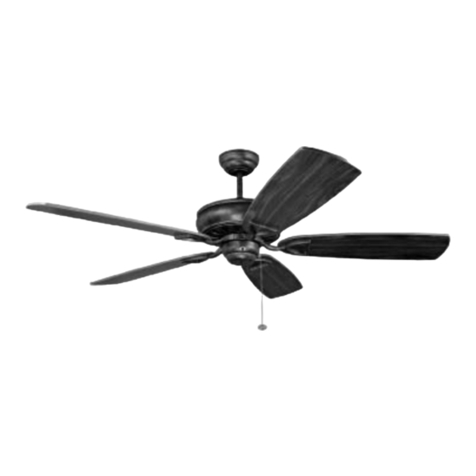
Ellington
Ellington SUA62BNK5 installation guide

Harbor Breeze
Harbor Breeze CENTREVILLE 40117 installation guide
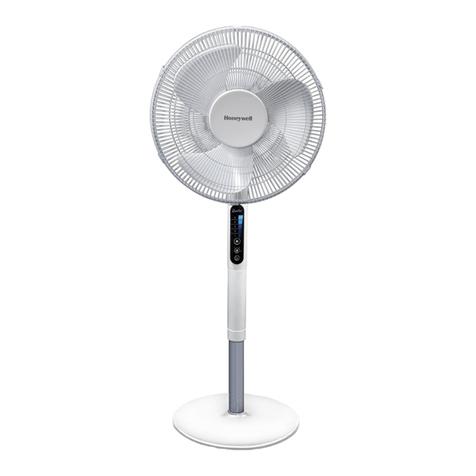
Honeywell
Honeywell HSF600WE operating instructions
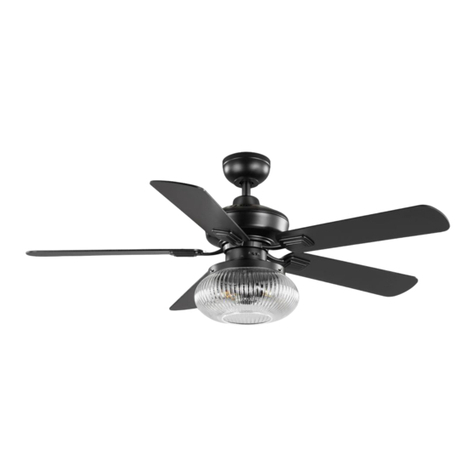
Home Decorators Collection
Home Decorators Collection RIMGATE 56048 Use and care guide
